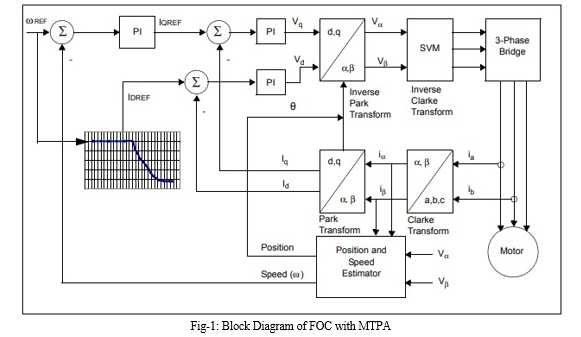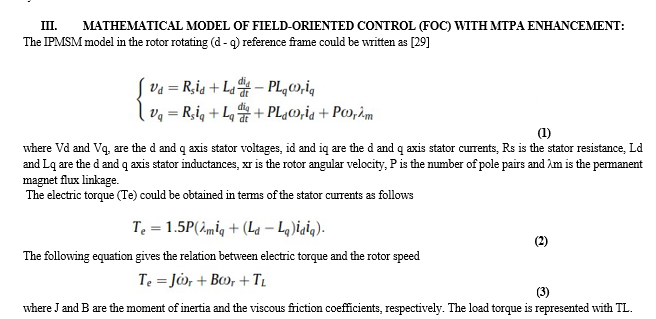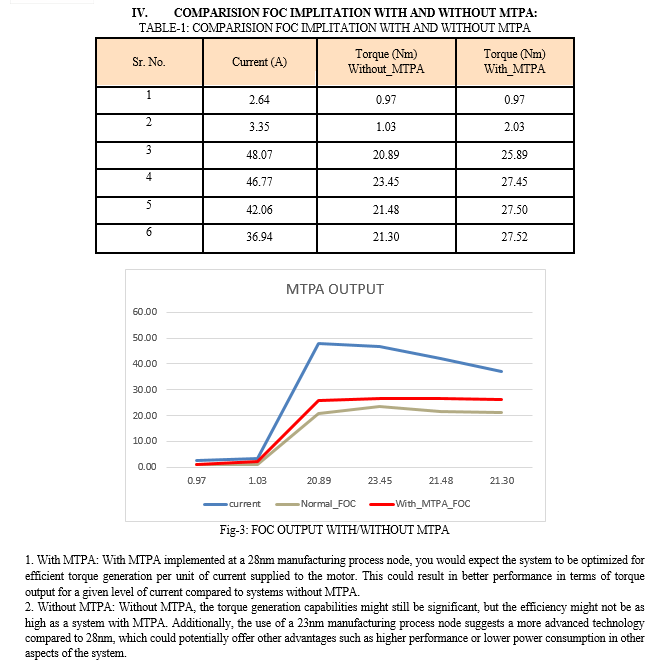Ijraset Journal For Research in Applied Science and Engineering Technology
- Home / Ijraset
- On This Page
- Abstract
- Introduction
- Conclusion
- References
- Copyright
A Study Article of Advancing Electric Motor Performance through Maximum Torque Per Ampere (MTPA) Control
Authors: Krunal Chavda, Sweta Panchal, Kuman Siddhapura
DOI Link: https://doi.org/10.22214/ijraset.2024.61378
Certificate: View Certificate
Abstract
Electric motor performance can be significantly enhanced through the implementation of Maximum Torque per Ampere control. This advanced control technique allows for optimizing the motor operation by maximizing the torque produced per unit of current. By implementing MTPA control, electric motors can achieve higher efficiency, reduced energy consumption, and improved overall performance. This paper explores the principles and benefits of MTPA control and provides insights into its application across various electric motor systems. The implementation of Maximum Torque per Ampere control has garnered significant attention in the field of electric motor performance enhancement. This advanced control technique offers a promising opportunity to optimize motor operation and achieve higher efficiency. By maximizing the torque produced per unit of current, MTPA control not only reduces energy consumption but also improves the overall performance of electric motors. Furthermore, the application of MTPA control has shown promising results across various electric motor systems, making it a versatile and impactful advancement in the field.
Introduction
I. INTRODUCTION
In the pursuit of enhancing the efficiency, reliability, and performance of electric motors, researchers and engineers have continuously sought innovative control strategies. Among these, Maximum Torque Per Ampere (MTPA) control stands out as a promising approach that offers significant advantages in various applications. MTPA control is a sophisticated technique designed to optimize the operation of electric motors by maximizing torque production per unit of current, thereby improving efficiency and enabling superior performance across a wide range of operating conditions.
Electric motors play a pivotal role in numerous industrial, commercial, and residential applications, powering everything from electric vehicles and industrial machinery to household appliances. However, traditional control methods often fall short in fully exploiting the potential of electric motors, leading to suboptimal efficiency and performance. This limitation has spurred the development of advanced control strategies like MTPA control, which aims to address these challenges and unlock new levels of motor efficiency and performance.
At its core, MTPA control leverages sophisticated control algorithms to adjust the motor's operating parameters in real-time, ensuring that it operates at the optimal point on its torque-speed characteristic curve under varying load and speed conditions. By precisely regulating the flux and torque components of the motor current, MTPA control maximizes the torque output while minimizing the current drawn from the power supply, leading to improved efficiency and reduced energy consumption.
The application of MTPA control extends across a wide range of motor types, including induction motors, permanent magnet synchronous motors (PMSMs), and brushless DC motors, among others. Its versatility and effectiveness make it a compelling choice for diverse industrial sectors, including automotive, aerospace, robotics, renewable energy, and more. Whether it's optimizing the performance of electric vehicles, enhancing the efficiency of industrial machinery, or enabling precise control in robotics applications, MTPA control offers unparalleled benefits that pave the way for advancements in electric motor technology.
In this review paper, we delve into the principles, development, implementation, and applications of MTPA control, aiming to provide a comprehensive understanding of its significance in advancing electric motor performance.
We examine the theoretical foundations of MTPA control, explore state-of-the-art control algorithms and optimization techniques, and discuss real-world applications and case studies demonstrating its efficacy. Furthermore, we identify emerging trends, challenges, and future research directions in the field, highlighting the immense potential of MTPA control in shaping the future of electric motor technology.
Through this comprehensive exploration, we aim to shed light on the transformative role of MTPA control in optimizing electric motor performance, driving efficiency gains, and facilitating the widespread adoption of electric propulsion systems across various industries. As we navigate towards a more sustainable and energy-efficient future, MTPA control stands as a cornerstone technology, empowering the next generation of electric motors to achieve unprecedented levels of performance and efficiency.
A. Type Of MTPA
In the context of electric motor control, Maximum Torque Per Ampere (MTPA) strategies can be broadly categorized into several types based on their implementation and application. Here are some common types:
- Direct MTPA Control: Direct MTPA control techniques directly optimize the motor's operating conditions to achieve maximum torque per ampere. These methods typically involve complex mathematical models and optimization algorithms to determine the optimal control parameters in real-time.
- Indirect MTPA Control: Indirect MTPA control methods achieve maximum torque per ampere indirectly by controlling other motor parameters such as flux or current. By regulating these parameters, indirect MTPA control strategies aim to indirectly optimize torque production while ensuring efficient motor operation.
- Field-Oriented Control (FOC) with MTPA Enhancement: Field-oriented control (FOC) is a popular control technique used in electric motor drives to independently control the motor's magnetizing flux and torque-producing current components. FOC methods can be enhanced with MTPA control strategies to further optimize torque production while maintaining efficient operation.
- Sensorless MTPA Control: Sensorless MTPA control techniques eliminate the need for physical sensors (e.g., encoders, resolvers) to measure motor parameters such as speed and position. Instead, these methods rely on advanced algorithms and signal processing techniques to estimate the motor's state variables, enabling MTPA control without additional hardware.
- Adaptive MTPA Control: Adaptive MTPA control algorithms dynamically adjust control parameters based on changing operating conditions or motor characteristics. These methods can adapt to variations in motor parameters, load torque, or environmental conditions, ensuring optimal performance and efficiency over a wide range of operating conditions.
- Model Predictive Control (MPC) with MTPA Optimization: Model predictive control (MPC) is an advanced control technique that utilizes predictive models to optimize control actions over a finite time horizon. MPC methods can be combined with MTPA optimization techniques to predict future motor behavior and dynamically adjust control inputs to achieve maximum torque per ampere.
- Application-Specific MTPA Control: MTPA control strategies can be tailored to specific applications or motor types to address unique performance requirements or constraints. For example, specialized MTPA control methods may be developed for traction motors in electric vehicles, high-speed spindles in machine tools, or wind turbine generators in renewable energy systems.
These types of MTPA control strategies can be further customized or refined based on specific application requirements, hardware constraints, and performance objectives. By selecting the most appropriate MTPA control approach and optimizing its implementation, engineers can effectively enhance the performance, efficiency, and reliability of electric motors across various industrial sectors.
Field-Oriented Control (FOC) with Maximum Torque Per Ampere (MTPA) enhancement is a sophisticated control strategy used in electric motor drives to achieve optimal performance, efficiency, and torque production. This approach combines the principles of FOC, which allows independent control of the motor's flux and torque components, with techniques aimed at maximizing torque per ampere to further improve motor efficiency and performance.
II. BLOCK DIAGRAM
Here's a detailed block diagram illustrating the components and control loops involved in FOC with MTPA enhancement:

- Reference Generator:
- Generates reference signals for torque and flux based on desired motor performance criteria and operating conditions.
2. Current Control Loop:
- Controls the motor current to track the reference values provided by the reference generator. It includes:
- Current Regulator: Maintains the motor current within specified limits.
- PI Controller: Adjusts control signals to achieve desired current levels.
3. Flux Control Loop:
- Controls the motor flux to achieve the desired flux reference provided by the reference generator. It includes:
- Flux Regulator: Maintains the motor flux at the desired level.
- PI Controller: Adjusts control signals to achieve the desired flux.
4. Torque Control Loop:
- Adjusts the torque-producing component of the motor current to achieve the desired torque reference provided by the reference generator. It includes:
- Torque Regulator: Controls the motor's torque output.
- PI Controller: Adjusts control signals to achieve the desired torque.
5. MTPA Optimization Module:
- Calculates the optimal operating point for maximum torque per ampere based on the motor's characteristics and operating conditions. It includes:
- Mathematical Model: Represents the motor's torque-speed characteristic and efficiency map.
- Optimization Algorithm: Determines the optimal flux and torque references to achieve MTPA operation.
6. Field-Oriented Control Transformation:
- Transforms the three-phase motor currents and voltages from the stationary reference frame to the rotating reference frame (dq-frame) to facilitate independent control of flux and torque components.
7. Inverse Park and Clarke Transformation:
- Converts the desired torque and flux references from the dq-frame back to the stationary reference frame for implementation in the motor drive system.
8. Voltage Source Inverter (VSI):
- Converts DC input voltage to three-phase AC output voltage to drive the motor. It includes:
- Pulse Width Modulation (PWM) Generator: Generates PWM signals to control the VSI's switching devices.
- Power Electronics: Converts DC voltage to AC voltage with variable frequency and magnitude.
9. Electric Motor:
- Converts electrical energy into mechanical motion. It includes:
- Stator: Stationary part of the motor.
- Rotor: Rotating part of the motor.
- Windings: Conductors that produce magnetic fields when energized.
10. Sensors:
- Measure motor variables such as current, voltage, speed, and position for feedback control. Common sensors include:
- Current Sensors: Measure motor current.
- Speed Sensors: Measure motor speed.
- Position Sensors: Measure rotor position (e.g., encoders, resolvers, Hall Effect).
By integrating FOC principles with MTPA enhancement techniques, this control strategy enables precise control of motor torque and flux while maximizing efficiency by operating the motor at the optimal torque per ampere point. It is widely used in various applications requiring high-performance electric motor drives, such as electric vehicles, industrial machinery, and renewable energy systems.



Conclusion
In this paper, the research proposes a practical approach built on very low-resolution Hall-effect sensors to pro- vide an IPMSM in electric vehicles with accurate and effective torque management. The maximum torque per ampere (MTPA), field weakening control, and reduced- order observer of IPMSM for HECV are all presented in this study. Electric vehicles can save money, weight, and volume by replacing resolvers with low-resolution Hall- effect sensors. Because the rotor position estimation is based on a power closed-loop, even if the predicted rotor position has some deficiencies, the IPMSM can out- put accurate torque. The flux linkage and power com- potations are dependent on rotor speed, the suggested technique may have certain limitations in the low-speed zone. However, this strategy is a considerably more effective way to establish efficient and precise management of IPMSM, especially when the IPMSM is functioning under high-power, high-speed settings. The standard driving cycle performance requirements of the modelled FTP vehicle has been analyses for understanding the real model requirements of the vehicle [4]. Utilizing actual HEV load and modified engine characteristics, torque control is applied. The efficiency of the prosed system has been improved by 92%. It will serve as an effective IPMSM implementation and performance control to apply the suggested system to the HECV system to regulate it. The torque ripple also reduced in the proposed method.
References
[1] Wang Zhuoyonga, Yao Xiaodonga, Liu Jiakanga , Xu Liangxua, Tong Hui, Liu Kea (2023), Research on IPMSM Control Based on MTPA, [c] international conference. [2] Sun, Tianfu & Wang, Jiabin & Chen, Xiao. (2015). Maximum Torque Per Ampere (MTPA) Control for Interior Permanent Magnet Synchronous Machine Drives Based on Virtual Signal Injection. Power Electronics, IEEE Transactions on. 30. 5036-5045. 10.1109/TPEL.2014.2365814. [3] Zhang Yuan, Wei Haifeng, Zhang Yi, Li Yuanjiang, Liu Weiting Low speed MTPA high dynamic response control method for permanent magnet synchronous motor [j] Journal of Underwater Unmanned Systems, 2022,30 (02): 223-230. [4] Lou Tianhao Research on vehicle brushless DC motor control technology based on improved particle swarm optimization algorithm parameter identification [d] Zhejiang University, 2022. [5] Jorge Zambada and Debraj Deb Microchip Technology Inc. (2023). Sensorless Field Oriented Control of a PMSM, application note.https://ww1.microchip.com/downloads/en/Appnotes/01078B.pdf
Copyright
Copyright © 2024 Krunal Chavda, Sweta Panchal, Kuman Siddhapura. This is an open access article distributed under the Creative Commons Attribution License, which permits unrestricted use, distribution, and reproduction in any medium, provided the original work is properly cited.

Download Paper
Paper Id : IJRASET61378
Publish Date : 2024-04-30
ISSN : 2321-9653
Publisher Name : IJRASET
DOI Link : Click Here
 Submit Paper Online
Submit Paper Online

